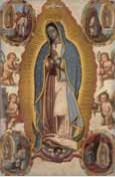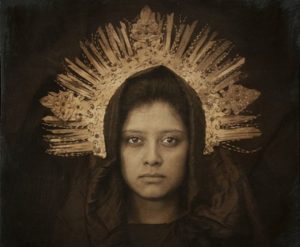 Long before Spaniards began settling in Latin America in the sixteenth century, Aztec religion offered a highly developed conception of a female deity called Tonantzin, the supreme Earth Mother. Tonantzin was the source of both life and death, a terrifying goddess who eventually consumed everything she created.1 Worship of Tonantzin became a dangerous enterprise with the 1519 arrival of Spanish conquistadors to Latin America. The Spaniards were set on eradicating native expressions of spirituality, and they attempted by force to establish Catholicism as the territory’s religion. In their Catholicism Mary played a prominent role, and the Spanish left a trail of Marian images and statues in villages they passed through, all the way from the Atlantic coast to Tenochtitlan (present-day Mexico City), the area’s capital and the center of Aztec worship.2
Long before Spaniards began settling in Latin America in the sixteenth century, Aztec religion offered a highly developed conception of a female deity called Tonantzin, the supreme Earth Mother. Tonantzin was the source of both life and death, a terrifying goddess who eventually consumed everything she created.1 Worship of Tonantzin became a dangerous enterprise with the 1519 arrival of Spanish conquistadors to Latin America. The Spaniards were set on eradicating native expressions of spirituality, and they attempted by force to establish Catholicism as the territory’s religion. In their Catholicism Mary played a prominent role, and the Spanish left a trail of Marian images and statues in villages they passed through, all the way from the Atlantic coast to Tenochtitlan (present-day Mexico City), the area’s capital and the center of Aztec worship.2
From the perspective of the Aztecs, Mary was originally associated with the death and destruction wrought by the Spaniards, and more specifically with the destruction of Aztec temples and statues of gods—statues that were often replaced with statues of Mary.3 For native peoples (and through the encouragement of Catholic priests eager to make converts), the Virgin Mary took on meaning previously ascribed to the Aztec goddess Tonantzin.
This association was strengthened by an event that took place in 1951 at a former site of Tonantzin worship. There, an Aztec peasant and convert to Catholicism named Juan Diego experienced a vision of Mary in which she called herself “La Virgen de Guadalupe” and expressed a desire for a church to be built at the site. She instructed Juan Diego to gather out-of-season roses and present them to the bishop as proof of her appearance. When Juan Diego opened his cloak, the roses fell out, and in their place miraculously appeared a painting of the Virgin on the inside of Juan’s cloak.
For the native people, this story took on multiple layers of significance. Mary—whose skin in the painting was native-toned—had appeared to one of them, on their land, and had inspired a peasant to confront the occupying powers with a demand for a uniquely native church. The Virgin of Guadalupe offered hope to the native peoples experiencing oppression at the hands of conquering foreigners, and the connection between the Virgin of Guadalupe and the goddess Tonantzin meant that a conduit had been created through which people so inclined were able to worship Tonantzin by a different name.4
The Virgin of Guadalupe became and still remains a symbol of Mexican independence, though her influence extends far beyond Mexico’s borders. Today, over ten million people per year visit the church that was built at the Virgin’s behest, making it the second-most visited Catholic church in the world (the first being St. Peter’s Basilica in the Vatican).5 Appearances of the Virgin Mary are part and parcel of the Latin American Catholic experience, but in terms of popular appeal, no others have come close to rivaling the apparition of the Virgin of Guadalupe.
Endnotes
1Patricia Harrington, “Mother of Death, Mother of Rebirth: The Mexican Virgin of Guadalupe,” Journal of the American Academy of Religion 56 (1988): 26.
2Ibid., 29.
3Ibid.
4Alberto Pereyra, “The Virgin of Guadalupe, History, Myth, and Spirituality,” Currents in Theology
and Mission 24 (1997): 348–54.
5“Our Lady of Guadalupe,” on the Catholic News Agency website, December 12, 2013, http://www.catholicnewsagency.com/saint.php?n=82.

